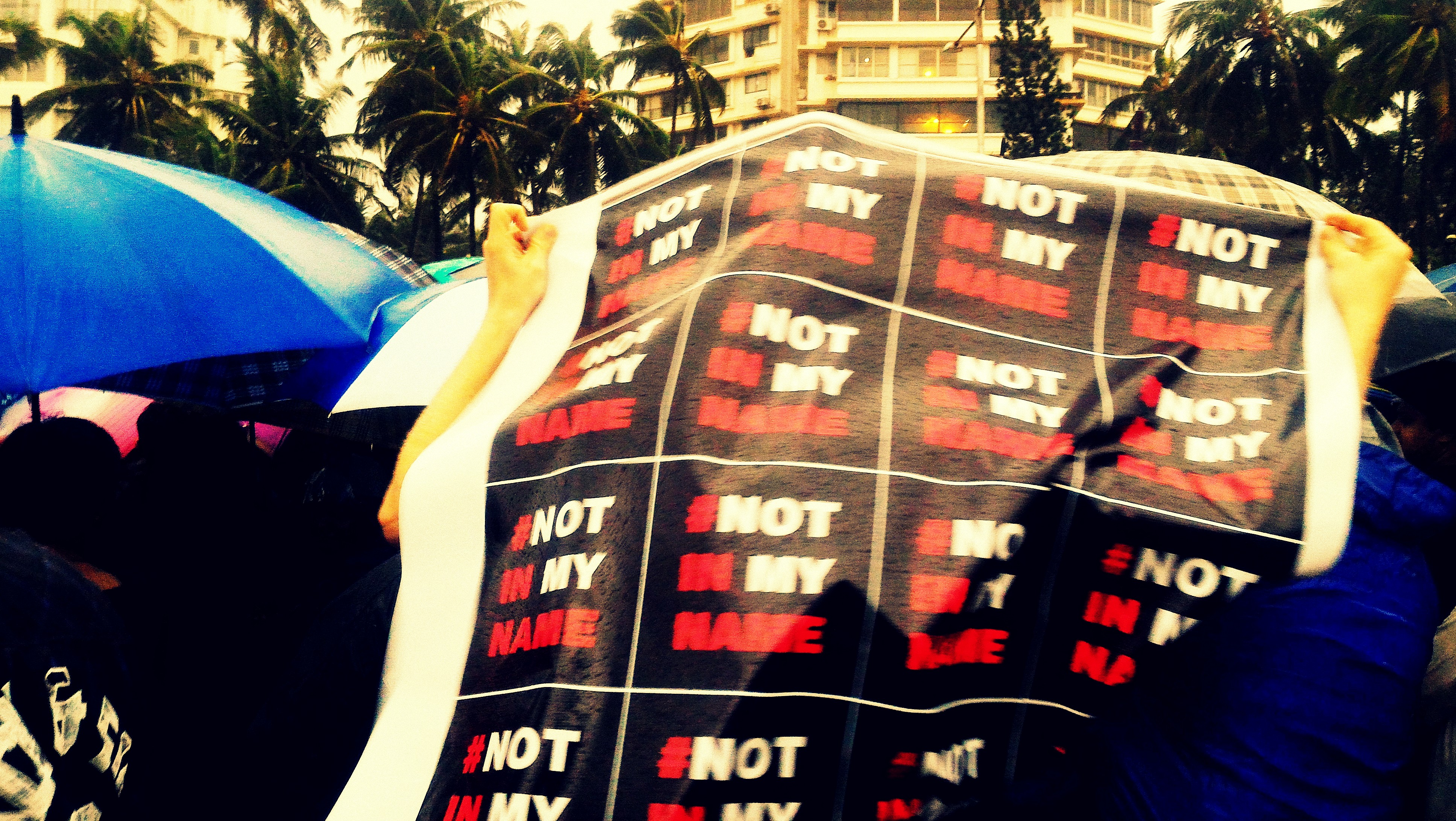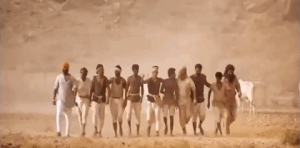#NotInMyName: Scenes From & Away From The Protests
There was no fixing the great gush in the sky. It had been raining incrementally since morning and the ground beneath the Mumbai local railways couldn’t soak it in anymore. I reached the railway station only to realize that there had not been a train for a while. The public had thronged the length and breadth of the platform. It should have been a petrifying sight, other than the fact that I see it every damn day- regular as eggs for breakfast.
But today, it threatened to boil over. A few fellow commuters were asking why people didn’t just invade the station master’s office and trash him to bits. People in Virar did it once and it worked like a charm, they said. He blamed this alleged impotency on the ‘sophisticated people’ who resided from Churchgate to Borivali. How will things ever get better for us, he lamented.
The statement had the kind of implied violence that is typical of local train exchanges. In fact, this was more eloquent than the usual – Push. Jump. Kick. Shove. Hit. Slam. I wouldn’t have paid it any mind but considering that I was returning from a protest of boy who was killed in a fight that began for his seat in an overcrowded train, it gave me pause.
3 Reasons
There were 3 reasons that compelled me to take part in the #NotInMyName protests at Mumbai:
1. A 16 year old child was publically abused, stabbed with knives and killed in the name of his religious identity. What was painful was not just the communal nature of the incident; but the fact that in its scorched fury, the mob had somehow failed to see that the victim was a child first. It failed to understand even that his identities could not have yet been fully formed. Or did it know and still act the way that it did? Have we just stopped caring for our 16 year olds?
2. Maybe no one was expecting a murder. Maybe some were complicit, some were just scared and some others could not be bothered. Society and law watched a mob wreak violence on the body of a 16 year old child and then, turned a blind eye. It’s been 18 months since we as a country opened up the legal possibility of awarding death sentences to minors. Public conversation around it indicated that it was a welcome move. The incident was the worst case manifestation of our fears as to which direction our country was heading with respect to our children and young people.
3. The horror of it was abstracted in a black and white image of a frail boy lying limp on the ground. Even drained of color, it is not impossible to see how profusely the child is bleeding. The portion between his torso and stomach has been digitally blurred. The violence that the mob wrought on the boy of a 16 year old was so heinous that it was not fit to be televised. What horror must the child have gone through?
‘This is not okay’- was what I wanted to express. But to whom do I express it to? And how do I say it? In an age of point of view overdose, what would be the point of it all? It was in the midst of this idiotic ‘to be or not to be’ floundering that I saw the news of the planned protest on social media. Finally, I felt that I had a found a time and a place and that I needed to be there.
The Protest
There was some confusion in the timings of the protest. While some tweets said 5pm others pegged it at an hour later. Thanks to social media effluvium, I was en route when I learnt that the protest was already underway.
The first few tweets I read were about Bollywood stars present at the site of protest. It was the kind of thing that would once annoy me. But when in Mumbai, one has to make peace with the fact that the logical end point of everything in the city is its inevitable Bollywood-ization. Coke Studio or #NotInMyName – doesn’t matter, it will turn into Bollywood. And anyway, the presence of stars gives increased visibility, helps spread the word, gets more people in….. you know how that goes.
I reached the venue a little after 6pm. I am a bad guesser of numbers, but I venture a crowd of around 300-400 or maybe 500 had gathered on the seaside promenade. The sky was gunmetal gray, the sea was a shade or two around that and this little collective was a burst of color in the midst of it all. The first glance of it in mid-distance was electric.
As I drew closer to the gathering, what I was hearing was a stoned silence. Those who had brought placards (silence is denial, not in my name, all we need is love etc) were quietly holding it up and a line of photographers were clicking at them from a vantage point. There is something remarkable especially in a Mumbai monsoon of a large crowd that gathers and makes no noise. For the next 5 minutes, the silence felt powerful. Then the pressure started to drop and it began to feel less like a crowd and more like a scatter. People were talking amongst each other:
“Who organized this protest?”
“Why aren’t more people turning up?”
“It is better in Delhi.”
“They are damning us with silence.”
The mind immediately recalls BBC documentarian Adam Curtis’ critique of hashtag revolutions. He views social media largely as a managerial tool. He credits it with the power to get the word around and get people to gather. But he also calls it out as a system of a control- where people are trapped in echo chambers of opinion, who gather together and preach to converted. He calls it a perfect system of management- where you feel as part of a collective while still retaining your individuality. Social media, according to him, doesn’t facilitate what revolutions & movements demand from the individual- to surrender one’s self to a larger vision.
He cites ‘Occupy Wall Street’ as an example of how movements get managed. In OWS, the pursuit to manage itself as a non-hierarchical uber-democratic structure manifested in its failure to define a common vision and goal. And thus, inspite of capturing the hearts and minds of people across the world, it was destined to fail.
The Music & The Rain

And just as I was about to fall under the dark spells of Mr. Curtis, there was a surge in the crowd. I could hear music. The center of the crowd was starting to move. About 5 to 10, maybe 20 people were singing and swaying. The sounds didn’t carry over the monsoon winds and the enthusiasm wasn’t really reaching the periphery of the crowd. But at least something was going down. Soon enough everyone was clapping, mostly atonally, to the tune of whatever one could hear.
Then the best thing to happen to the ragtag gathering came to pass. It rained. Umbrellas popped. The lashing rains pushed the periphery into the center. From a scattering, it turned into an amorphous mound under so much nylon. Suddenly the sound began to carry. A few among the group transitioned into chanting. It took a while to get a tune around the words ‘Not In My Name’ but we did it. For a brief moment, the claps were in tune, the slogan was on everyone’s lips, there was an energy and rhythm to it. People were singing even as they were capturing with their cell phones other people who were singing and shooting the protest. This sustained for around 10 minutes.
And then someone went to the tune of “It’s seven already, you guys. We have to shut down.”
And everybody else went “You are 100% right, brother.”
And I checked my watch. It wasn’t even seven yet.
The Way Back
I was feeling pretty good. For a brief moment, I had felt a part of something bigger. But the more I moved away from the venue, questions started gnawing at my good feelings from within- what were we a part of? I was there for the above 3 reasons, but why was the girl next to me clapping? Maybe that’s what resistance feels like. I couldn’t tell.
I was reminded of the comedian Stewart Lee. In one of his sets he mentions that what he aims for with his comedic sets was not laughter but ‘some sort of mass liberal consensus’. He goes on to imply that this consensus was a quantity so volatile that it dissipated on contact with air. As I negotiated traffic and rain and muddy waterlogged roads, far away from the site of protest, Mr. Lee felt remarkably spot on.
A Shared Discontent
So I stood for my train, weary and wet, on an platform that teemed with more life per square inch than an earthworm farm, I realized that in some distant way, I had shared and experienced some of that blind fury. It was discomforting to admit to myself but the fundamental anger of travelling crushed in a train filled beyond capacity is a very real thing. And I knew it from every other day.
That day on my commute back from the protest, everyone in my compartment was steamrolled. We are crushed against each other, we stepped on each other’s toes, we elbowed each other’s guts and despite all of this, I had to skip a station because I’d literally have to lynch someone to get off where I wanted to.
Where are the Alternate Narratives?
 There is now in the air, a violent national narrative that has given expression to this very real discontent that exists at the grassroots- one that implies that ‘other people’ are denying you the comfort that you are entitled to and that you can seize it with no questions asked. In seizing it, the narrative casts you as a hero who restored justice not unlike the good people of Virar who allegedly thrashed the station master and got the trains to run on time.
There is now in the air, a violent national narrative that has given expression to this very real discontent that exists at the grassroots- one that implies that ‘other people’ are denying you the comfort that you are entitled to and that you can seize it with no questions asked. In seizing it, the narrative casts you as a hero who restored justice not unlike the good people of Virar who allegedly thrashed the station master and got the trains to run on time.
This narrative arc is fully developed with indignities dug up in the past, a revolutionary rise set in the present, dominance in the near future and ultimately deliverance and a bright thereafter. It has a simplistic fable like quality that has caught imagination and continues to be sold like so much quack jadi-buti for all of the nation’s problems.
It is a dangerous domino that has been set in motion with the potential to witchhunt one vulnerable minority after the other. But its deviousness has found currency primarily because it taps into existing and real public anger. That is where other narratives have failed. They did not acknowledge ground realities and they let it fester.
This singular narrative of hate thrives because movements against it have struggled to deliver a credible alternate narrative that is robust enough for a large part of society to subscribe to. #NotInMyName in the way that it unfolded before my eyes, offers little in this regard. By chanting it, I may have distanced myself from the narrative of hate which is good but that’s just me as an individual and in my own way. My outrage was managed. I had a moment of uplift for around 10minutes. Been there. Done that. And I reached home late, exhausted and disheveled and ate my dinner that was cold.
The We and The I
By failing to acknowledge larger discontent at the grassroots, the #NotInMyName movement inadvertently seeks to maintain a status quo that most people are tired of. The collective ‘my’ that haunts the phrase is no longer a tenable proposition from which a movement for larger change can be sustained.
There is no such thing a collective ‘my’. We shouldn’t be deluded into thinking otherwise.
It is a damn shame that i went to a protest and came back to write a first person experience. But frankly, I would be lying if I said that I felt that there was a collective narrative in there that I could describe.
I still have the hope of write in first person plural in the near future. In a time when mere children are being killed over train seats and food habits, I hope and pray that its sooner than later.














